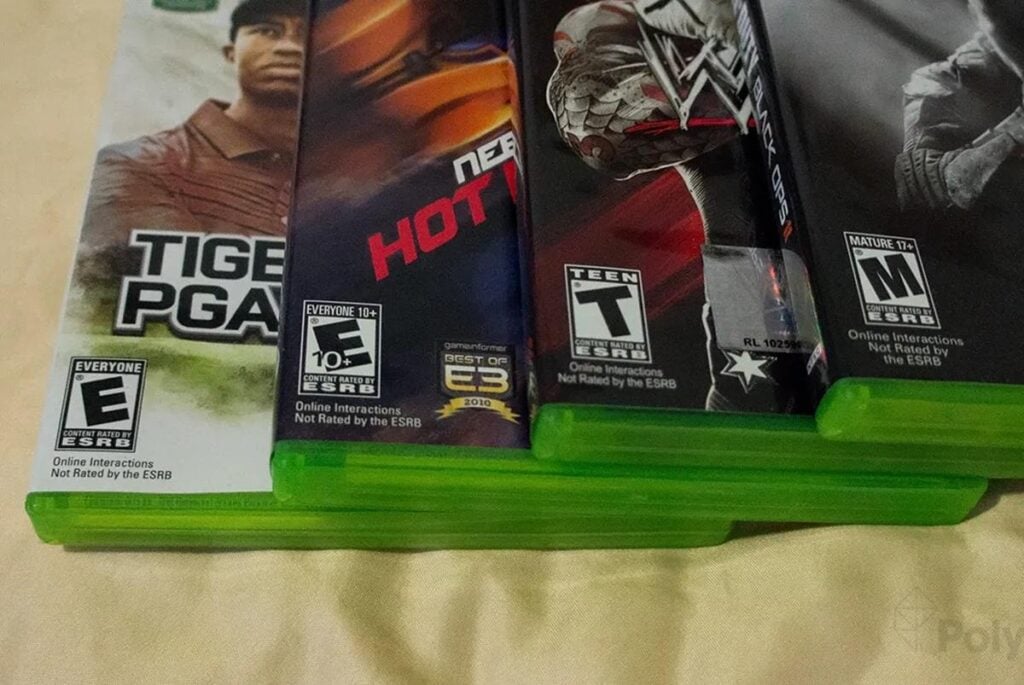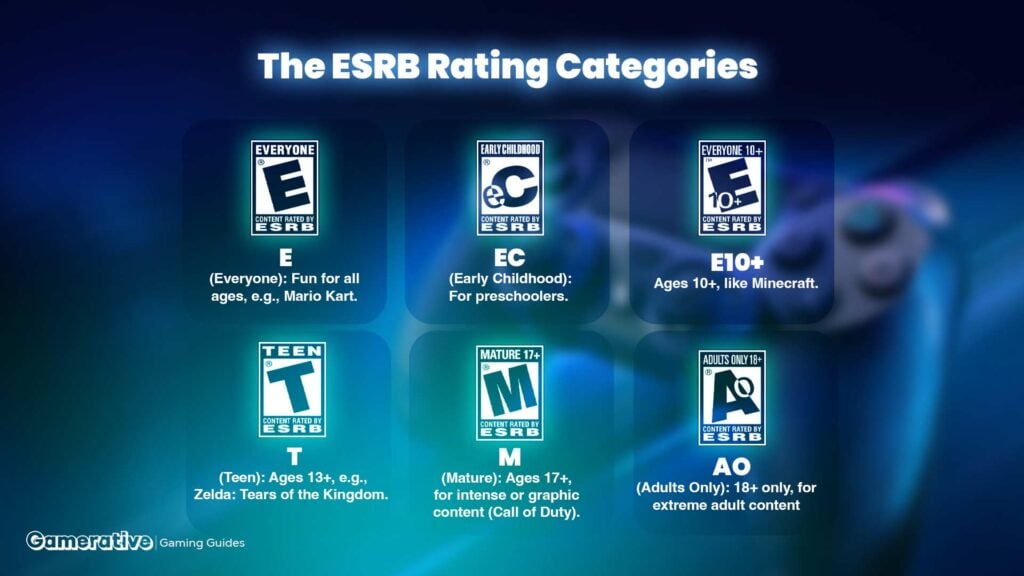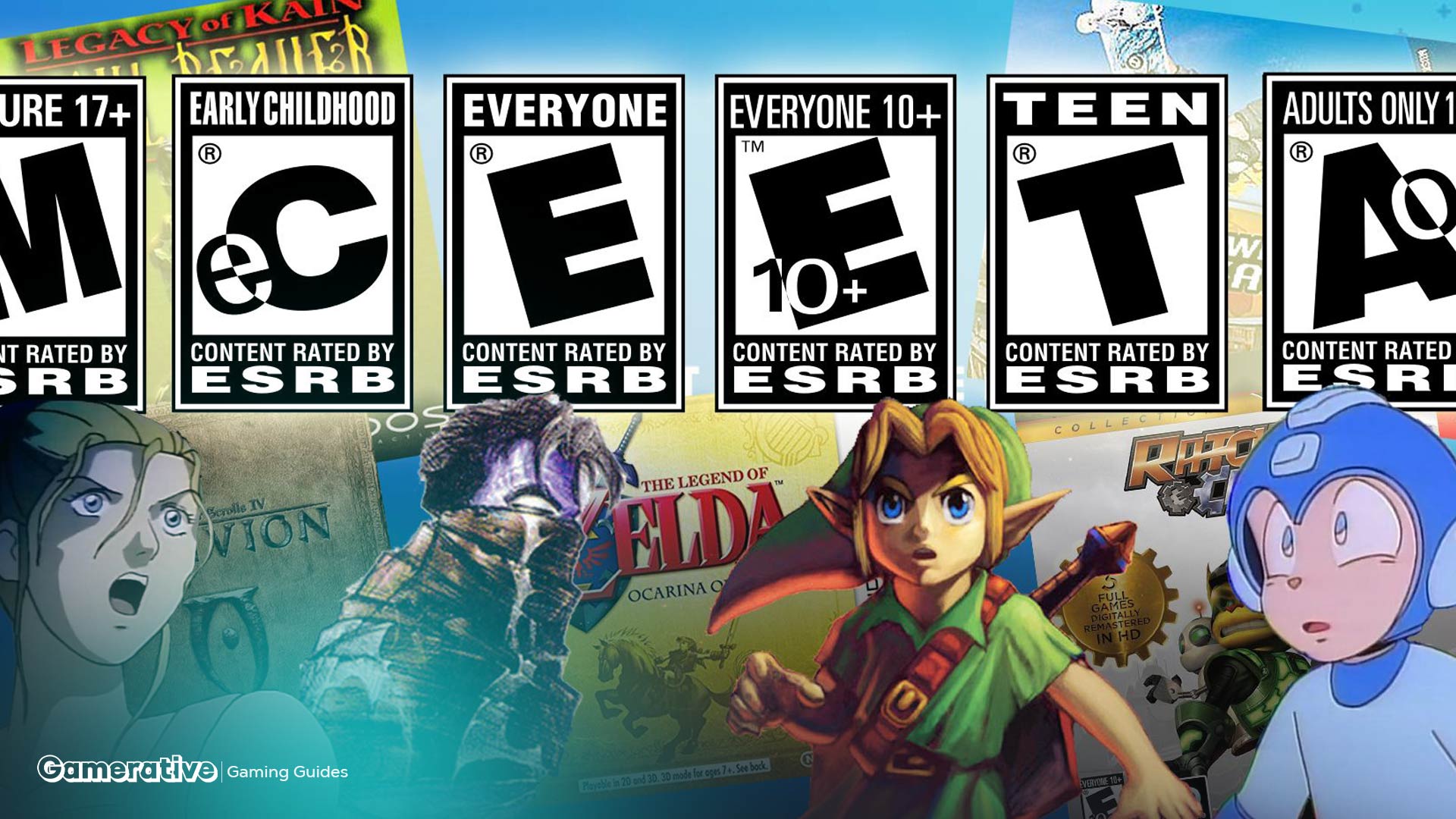When we first started gaming, we weren’t always paying attention to those little squares with letters on the box art. Our parents, on the other hand, often flipped the game case over, scanning for symbols that could mean “too scary,” “too mature,” or “absolutely safe for everyone.” Game ratings might seem like boring fine print, but honestly, they’re essential to making sure every player, especially families and kids, gets the experience they expect (and nothing more). So, what are ESRB ratings? Grab your controller and let’s walk through the basics, with a few stories along the way.
What Are ESRB Ratings?
If you’ve ever asked, “What are ESRB ratings?” you’re not alone. ESRB ratings are labels placed on video games in North America, giving players and parents a quick sense of what sort of content is inside. The ESRB (Entertainment Software Rating Board) reviews games and sets these ratings, similar to how the MPAA rates movies. From “E for Everyone” platformers to “M for Mature” shooters, this system helps gamers make safe, informed choices every time they pop a new game into their console or download from an app store.
1. Introduction: The Need for Game Ratings in Modern Gaming
Growing up around games, most of us eventually realized that not all titles were created equal. Ratings appeared so parents could protect younger kids, teens could find what’s right for them, and adults could spot content that’s a bit more intense. We’re breaking down who sets these ratings, what they mean, and why they matter more than ever in today’s diverse world of gaming.
2. What is the ESRB?
Let’s begin our discussion about “What are ESRB ratings?” with a little history lesson. Back in 1994, the Entertainment Software Rating Board (ESRB) was created as an independent, non-profit group to bring order and transparency to the wild world of game content. Think of the ESRB as the gaming version of movie ratings: it’s the trusted authority for video game age ratings, especially in the U.S. and Canada. Retailers, parents, and gamers rely on ESRB scores when making decisions, whether they’re in a giant chain store or browsing online.

3. How Are ESRB Ratings Determined?
You might imagine rooms full of people glued to games for hours, but the process is a little different. Publishers submit video footage and detailed descriptions of the most intense, potentially controversial moments. Raters, who work anonymously for fairness, carefully review every snippet, looking closely for things like violence, language, substance use, sexual content, and gambling references. Ratings can be updated if new content is submitted (e.g., expansions or re-releases), but it’s not automatic; developers must resubmit for a re-rating. The process isn’t continuous unless prompted.
4. Understanding the ESRB Rating Categories
What are ESRB ratings? When scanning a game shelf, those little icons make all the difference. Here are the main ones you’ll see, with examples:
- EC (Early Childhood): Aimed at the youngest players; think preschool games or classics like Sesame Street titles.
- E (Everyone): Games like Mario Kart 8 Deluxe; suitable for all ages, often light-hearted fun.
- E10+ (Everyone 10 and Up): Minecraft (Java Edition) fits here, with a tiny bit more cartoon mischief or mild fantasy violence.
- T (Teen): Titles like The Legend of Zelda: Tears of the Kingdom bring in moderate violence, some language, or suggestive themes.
- M (Mature, 17+): Intense action games such as Call of Duty or The Last of Us Part II, meant for grown-ups, with graphic content.
- AO (Adults Only, 18+): Rare to see, and often not sold in major stores; these contain explicit adult material.

- Ratings are displayed on game boxes and digital store pages for easy reference.
5. What Do ESRB Content Descriptors and Interactive Elements Mean?
Right next to the rating symbol, you’ll often notice extra labels: content descriptors and interactive elements. Content descriptors highlight why a game landed its rating: things like “Comic Mischief,” “Blood and Gore,” or “Simulated Gambling.” Interactive elements are newer, warning about features like “In-Game Purchases,” “Users Interact,” or “Shares Location.” These warnings are lifelines for parents hoping to avoid surprises like spending sprees or unmoderated voice chat.
6. ESRB Ratings Across Platforms: Console, PC, and Mobile
To realize what are ESRB ratings and how important they are, know that no matter where you buy games, be it physical boxes, Steam on PC, or your go-to mobile app store, ESRB ratings are woven into North American releases. They’re easy to spot on PlayStation, Xbox, Nintendo Switch, and most digital storefronts. Occasionally, certain mobile or indie games won’t show an ESRB rating, especially on global app stores, but the big shops and devices take these seriously.

7. How Do ESRB Ratings Help Gamers and Parents?
When we pick a new game for family night or for friends, those ratings become our north star. Parents can keep kids safe; teens get clear guidance; adults know when a game really earns its “M” rating. Studies show most families do check ESRB marks before buying, and it’s a smart move to chat about ratings at home; sometimes what’s right for one 10-year-old won’t fit another. Ratings open the door for good conversations about what’s actually in a game before you dive in.

- ESRB ratings guide responsible purchasing and help manage age-appropriate gaming.
8. Common Myths and Misunderstandings About ESRB Ratings
Lots of misunderstandings pop up when trying to know the answer to “What are ESRB ratings?”. The ESRB doesn’t police who can buy a game; that’s up to the store and parents. Not every video game you find online has been rated, especially small indie titles or imports. And “M-rated” isn’t evil; it just means the game’s meant for older players, not little kids. Remember, ratings are an info tool, not censorship. They’re about trust and transparency, letting players and parents decide.
9. Closing Things Up: Why It Pays to Pay Attention to ESRB Ratings
Realizing the answer to “what are ESRB ratings?” can be valuable, as a quick glance at an ESRB rating can save a lot of confusion and disappointment. Game age ratings give families, gamers, and educators control, helping everyone choose experiences that fit their own household rules and comfort zones. Next time you’re shopping for a new title, take a second to check the rating… and let us know if ESRB labels have ever helped (or surprised) you in the comments!
Learn about the inside out of video games world and industry via Gamerative.
FAQs About ESRB Ratings
Q1: Who pays for ESRB ratings, developers, or publishers?
Publishers pay a fee for the review, covering the costs of running the non-profit ESRB rating system.
Q2: Can a game’s ESRB rating change after release?
Yes, especially if new content, updates, or downloadable expansions add fresh material that wasn’t included in the initial review.
Q3: Why are some games in app stores missing ESRB ratings?
Some mobile game platforms use their own rating tools or self-reporting, so not every app undergoes a full ESRB review, especially outside North America.
Q4: Does every retailer enforce ESRB ratings for sales?
Enforcement varies by store and region. Most major retailers in the U.S. check ID for “Mature”-rated games, but digital storefronts often rely on parental controls.




